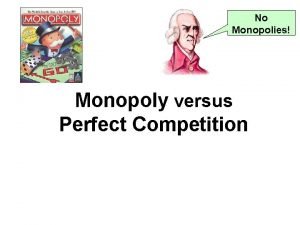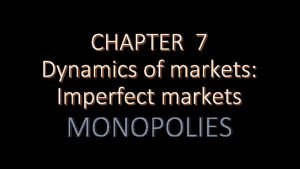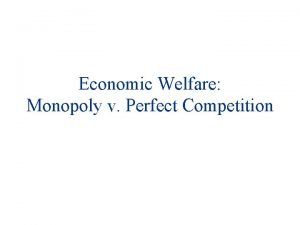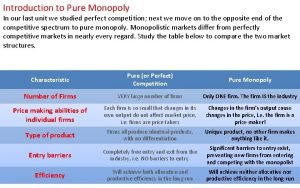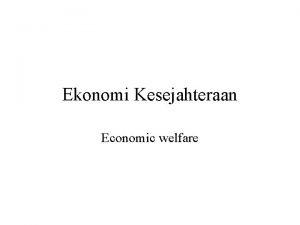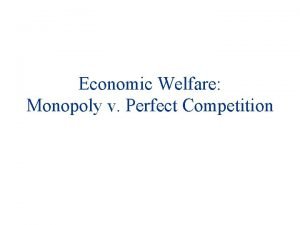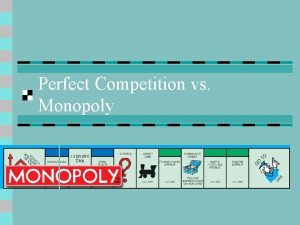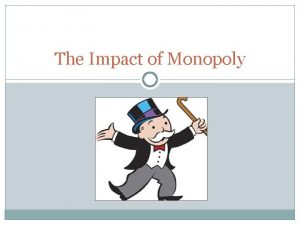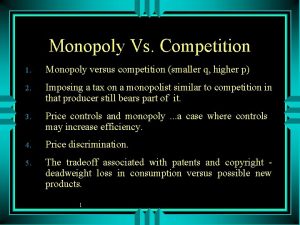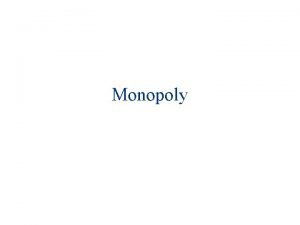Economic Welfare Monopoly v Perfect Competition Agenda u




















- Slides: 20

Economic Welfare: Monopoly v. Perfect Competition

Agenda u Societal Welfare/Economic Welfare: Criteria Consumer Surplus Producer Surplus u Compare Monopoly and Perfect Competition u Price Discrimination

Economic Welfare u Consumer surplus measures economic welfare from the buyer/consumer perspective. u Producer surplus measures economic welfare from the seller/producer perspective.

Consumer Surplus u Consumer surplus is the amount a buyer is willing to pay for a product minus the amount the buyer actually pays. u Consumer surplus is the area below the demand curve and above the market price. A lower market price will increase consumer surplus. A higher market price will reduce consumer surplus.

Producer Surplus u Producer surplus is the amount a seller is paid for a product minus the total variable cost of production. u Producer surplus is equivalent to economic profit in the long run.

Economic Welfare u Economic welfare can be quantified as the sum of consumer surplus and producer surplus, i. e. equal weights assumed.

Consumer Surplus and Producer Surplus: Market Equilibrium Price A D Supply Consumer surplus Equilibrium price E Producer surplus B Demand C 0 Equilibrium quantity Quantity

Monopoly v. Perfect Competition u Monopoly and perfect competition can be compared/contrasted by using consumer surplus and producer surplus (i. e. by using economic welfare/societal welfare measures).

Monopoly v. Perfect Competition MC P For PC, output will be set at P = MR = MC Recall that for PC: MR=AR=Demand Qpc Demand Q

Monopoly v. Perfect Competition MC Price is Ppc P Ppc Qpc Demand Q

Monopoly v. Perfect Competition MC P Recall that for monopoly, MR Demand Output is set where MC = MR Ppc Qm Qpc MR Demand Q

Monopoly v. Perfect Competition MC The monopoly output is less than the perfectly competitive output P Pm Ppc Qm Qpc MR Demand Q

Monopoly v. Perfect Competition MC The monopoly output is less than the perfectly competitive output. P Pm (The monopoly price is higher than the perfectly competitive price. ) Ppc Qm Qpc MR Demand Q

Monopoly v. Perfect Competition MC P Pm Ppc Qm Qpc MR The green area represents the deadweight loss (triangle) of Monopoly Demand Q

The Deadweight Loss (“Triangle”) MC “Loss” in consumer surplus Demand The green area from the previous diagram has been enlarged.

The Deadweight Loss (“Triangle”) MC “Loss” in producer surplus Demand The green area from the previous diagram has been enlarged.

The Deadweight Loss (“Triangle”) MC CS PS CS+ PS = welfare loss associated with monopoly = DWL Demand

The Deadweight Loss (“Triangle”): Allocative Inefficiency MC CS+ PS = welfare loss = DWL CS PS Demand Allocative inefficiency: (P MC) Allocative Inefficiency: DWL

Economic Efficiencies: Monopoly v. Perfect Competition Allocative Efficiency Productive Efficiency Excess profit X-inefficiency Technical progress Comment P = MC PC v. M PC M X Minimum point on AC Curve PC M X? (Check) PC M X PC M ? PC ? M ? Rent seeking? Cost inflation R&D

Price Discrimination Monopoly v. Perfect Competition u u u First degree (perfect) price discrimination – Each consumer pays her/his reservation price. The producer/ seller captures all consumer surplus – Implication for Monopoly v. Perfect Competition? (MR = AR P = MC in monopoly, i. e. allocative efficiency) Second degree price discrimination – Bulk discounting – Non-linear pricing Third degree price discrimination – different prices to different groups.
 P = mc
P = mc Monopoly and oligopoly examples
Monopoly and oligopoly examples Difference between perfect competition and monopoly
Difference between perfect competition and monopoly Dynamics of imperfect market
Dynamics of imperfect market Characteristics of a monopoly
Characteristics of a monopoly Difference between perfect competition and monopoly market
Difference between perfect competition and monopoly market Competition refers to
Competition refers to Monopoly vs monopolistic competition
Monopoly vs monopolistic competition X-inefficiency
X-inefficiency Lerners index
Lerners index Monopoly deadweight loss
Monopoly deadweight loss Advantages of monopoly
Advantages of monopoly Deadweight loss in monopoly
Deadweight loss in monopoly Pure competition and monopoly _____
Pure competition and monopoly _____ Difference between monopoly and monopolistic competition
Difference between monopoly and monopolistic competition Monopolistic competition pictures
Monopolistic competition pictures Monopoly in economics
Monopoly in economics Market structures venn diagram
Market structures venn diagram Economic welfare adalah
Economic welfare adalah Economic welfare
Economic welfare Agenda sistemica y agenda institucional
Agenda sistemica y agenda institucional
